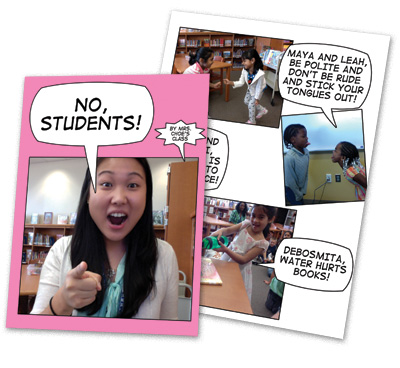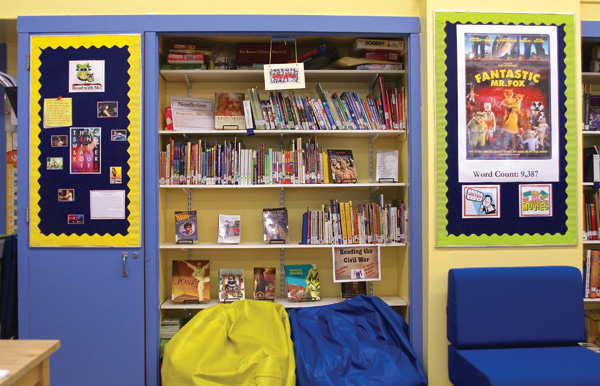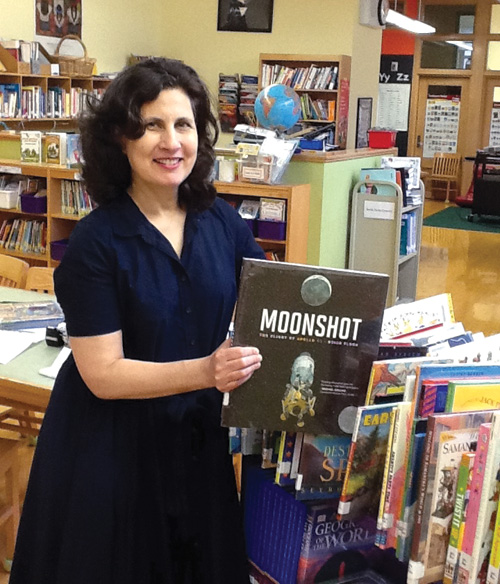Set the Right Course for Back to School

Illustration By Richard Faust/Lindgrensmith.com
During my first week back at my public high school in New York City, I’m always running in 10 different directions. I do library tours, scavenger hunts, introductory emails, workshops, meetings—and more meetings. I want to reach out to faculty while they’re shaping their curricula. I also want to welcome students back and help newcomers fall in love with the place that many of them call “home away from home.”
Students test boundaries and rules in the first weeks, too, especially if the library feels comfy and homey. That’s when librarians need to show that they can manage the group in creative ways.
How do you set yourself on course and set the right tone amid the September scramble? I asked librarian colleagues to share their best tips.

Matthew Winner’s students create rule books with the app Comic Life.
Classroom management isn’t often covered in library school, but librarians have invented creative ways to keep the peace. Matthew C. Winner, library media specialist at Ducketts Lane Elementary School in Elkridge, MD, aims to make “something interesting out of boring information”—i.e., rules. His first graders make a rule book with Comic Life including photographs of themselves pretending to eat, spill drinks on books, do karate punches, etc. Winner counts down—“One, two, three, FREEZE!”—when taking their pictures. His library is a “lively, noisy, exciting” place, he says, and this activity helps them remember rules. They often come back to look at the pictures, and Winner uses older kids’ books as show-and-tell for younger classes.
Winner also reads aloud Mike Thaler and Jared Lee’s The Librarian from the Black Lagoon (Scholastic, 1997) to introduce the library. He uses the refrain “OR ELSE!” to make kids laugh as he cites examples of misbehaving from the book and students’ imagination. Don’t throw books, OR ELSE, you’ll be dropped in a swamp!
Lauren Soucy, a former elementary school librarian in New York City, introduced students to book care basics through Oliver Jeffers’s The Incredible Book-Eating Boy (HarperCollins, 2006). “I’m trying to shift away from a ‘rules for rules’ sake’ approach,” she says. Jacqueline Woodson’s Each Kindness (Penguin, 2012) helped Wolf teach a lesson on showing consideration in the library.
Musical management
It can take years to build a fully stocked classroom management toolbox—which can even contain a variety of musical instruments. A former dean of my school, from Burma (now Myanmar), gave me a gold gong imprinted with an elephant, and a striking stick that was carved from a tree branch. When students’ voices are rising, or someone is eating or dancing, I strike the gong. Its rich sound lifts students out of the moment and invites them into a more reflective space. I’ll ask them to look around. Is someone using a book as a coaster for soda? Is there a group practicing their Shakespeare lines a bit too dramatically? The gong helps us refocus.
Some elementary librarian colleagues use chimes or wrist bells, or clap three times to pull a group together. “Hands on top, now we stop!” Cheryl Wolf, librarian at the Neighborhood School and S.T.A.R. Academy in New York City, will call out, and the children will all put their hands on their heads and look at her. Many elementary librarians prevent chaos by setting up a careful structure for browsing and book checkout, with built-in rewards for those who follow instructions. Soucy assigned seats and called one table at a time to check out books. She called with a normal speaking voice. If a table was too talkative and didn’t hear, they missed their chance for the week.
At checkout time, Wolf gives a select group of students a shelf marker (a wooden paint-stirrer stick decorated by students). The others sit at the table and page through magazines and books. Only the students holding shelf markers can roam the library. This lets Wolf offer book-selection guidance to small groups and creates a calmer environment.

Lauren McBride takes to Twitter and her school library web site to get students and
the community involved in events like a shelving party at her brand-new library.
Photo by Sapna Venkatachalam/Loudoun County Public Schools.
Setting the stage for September
Lauren McBride uses Twitter during the summer to take the pressure off the first packed week. McBride, incoming librarian for a new library at Riverside High School in Leesburg, VA, has tweeted summer reading lists and retweeted tidbits from the Library of Congress and shared book publication news and items about the Paper Towns movie. “My goal is to establish the library as an essential place, both physically and virtually,” she says.
No matter how many new forms of social media we have, bulletin boards still offer a lot of mileage. Vanessa Nutter, librarian at Democracy Prep Endurance Middle School in New York City, is a serious “boarder.” She creates spreadsheets to plan how displays will align with teaching units.
Nutter also posts “student shout-outs” when her students reach their goal of reading one million words, or whatever their word-count target is. Students who reach their goal win free T-shirts. Her “Read-with-me board” includes an image of the book the librarian is reading, inviting conversation. A "Now Playing" board showcases posters of film adaptations of library books. Nutter’s carefully planned boards remind us that the display areas are for more than decoration; they can create a culture of reading.

Vanessa Nutter’s bulletin boards involve students and help create a culture of reading at her school library.
Courtesy of Democracy Prep Public Schools.
Objects that engage
As incoming head librarian at the Girls Division at Regis Jesuit High School in Aurora, CO, Jamie Lee Schombs will pay special attention to new students and will bring an assortment of puzzles to welcome everyone, including “metal hand puzzles, Rubik’s Cubes, Tangles, [and] gel timers.” She also posts a “library riddle of the day.” These things make students feel more comfortable visiting the circulation desk.
I also devote energy to newer students and decorate my circulation desk with objects that welcome conversation. A large, flat rock has the words “Turn me over” written in black. Students flip it over to find the message: “In research, leave no stone unturned.—Librarian Jess.” New students are always curious about the rock, and returning ones gravitate towards this object, literally a touchstone. “It’s still there!” they say, pleased. Some turn the rock over and over every time they visit the desk; it helps them feel relaxed as we chat.
During my first week of school, ninth graders participate in “personalized scavenger hunts” in which students find titles that interest them. My questions might ask them to locate a book on an artist, country, or language they are curious about. I also ask subjective questions: What is the book in the library with the weirdest title or cover? I use different sets of questions for different groups. This means that a wider variety of books circulate, and I can run back-to-back hunts. I learn a lot about ninth graders by finding out who likes Andy Warhol or Frida Kahlo and who wants to read about Nebraska or Hawaii.
Teacher outreach
Nutter contacts her principal during the summer to request a professional development hour with teachers during the first week; last year, all the teachers attended. Winner offers modules for teachers to learn about Kindles, databases such as PebbleGo, and the MackinVia platform. McBride hosts a Bring Your Own Device workshop for the whole school community to learn how to access library resources via phone and tablets.
Winner enjoys a “grassroots approach” to connecting with teachers and asks them to chat for “three minutes” after lessons. In that time, he’ll demonstrate a new tool they haven’t used in class, whether it’s Skype, Google Docs, or computer programming. He may also invite teachers to watch their students demonstrate something they’ve learned.
Teachers are more willing to take risks when they know that curricula have succeeded previously, either in their classroom or a colleague’s. Winner likes to build on previous lessons, taking a template that worked before and making the lesson more sophisticated. I also like to start the school year by building on last year’s accomplishments. “Your bilingual reading program was so awesome last year,” I might say to our Spanish teacher. “Do you want to do it again? Should we tweak the lesson a bit?”
Map out the year
Planning collaborative projects with many teachers can be overwhelming. Why not start with three? At my school, a health teacher does her infectious disease research project in September, a teacher in our Literature Department likes scavenger hunts linked to his curriculum, and one of the science teachers assigns the environmental studies project in December. That’s already a fairly hefty schedule.
Continue sending emails reminding teachers that you’re available; have lunch or friendly hallway chats with colleagues; and ask teachers about their curriculum and offer ways to be involved. Send faculty online resources or recommendations after you’ve heard about their classes to show that you were really listening and that you can be a resource. I also secure interlibrary loan books and purchases for teachers to supplement their own scholarly work.
Also, remind everyone about the different ways you can work with their students. I have three modes of teaching: in the main library area; in different teachers’ classrooms using a whiteboard for full periods or mini lessons; and with one-on-one research instruction by appointment in the library office. Sometimes teachers want to send me three students who are struggling with citation, or they prefer that I stop by their classes for 10 minutes. Teachers have a harder time declining your help if you give them many options and are flexible.

“Hands on top, now we stop!”
is Cheryl Wolf’s upbeat call to order.
Showcase students
Many librarians create activities that give students a feeling of ownership of the library experience. Soucy’s elementary students designed colorful library cards that they would use every time they checked out a book. I make time during my first few weeks to promote the role of student interns, who often teach others basic library skills during the beginning of the school year. Recruiting and signing up volunteers can be quick with Google Surveys, where I obtain helpful data (about students’ favorite books and movies) and create a database of volunteer contact information. McBride used Twitter and Sign Up Genius to invite student and community volunteers to a shelving party to get her library ready for the first day of school, with donuts for all.
Tapping into a larger school initiative can invigorate a library orientation. My students have a special writing workshop, following Bard College’s Writing and Thinking model (http://ow.ly/QI5Ie) instead of regular classes during their first week, and they produce notebooks full of creative and analytical writing. I teach creative writing workshops, participating in the school culture of contemplative writing.
McBride’s school district uses the One to the World instructional initiative, encouraging students to create projects for an audience beyond the classroom. Many of her orientations for staff and students focus on how the library can support these projects.
Schombs will co-teach with a partner librarian during a larger school orientation program. They will follow a school tradition in which librarians meet and greet the new faculty over refreshments. “I am a new faculty myself,” she says, so the event has extra purpose.
Each fall, there are always many new faces and names to learn, and returning students arrive full of new ideas. You never know where someone’s summer has taken them. A student may have been obsessed with cookbooks and zombie novels last year, but now he could be all about detective novels and learning Swahili. Students will always surprise you, especially in September. Try to surprise them back.
RELATED
The job outlook in 2030: Librarians will be in demand
The job outlook in 2030: Librarians will be in demand
ALREADY A SUBSCRIBER? LOG IN
We are currently offering this content for free. Sign up now to activate your personal profile, where you can save articles for future viewing






Add Comment :-
Comment Policy:
Comment should not be empty !!!
Tracy Ferguson
I would LOVE to have a copy of one or two of those scavenger hunts--if you wouldn't mind sharing!!! tferguson@gilesk12.org I have a fixed schedule for Pre-K through 7th---and I am always looking for something to do with the middle schoolers!Posted : Sep 03, 2015 07:08